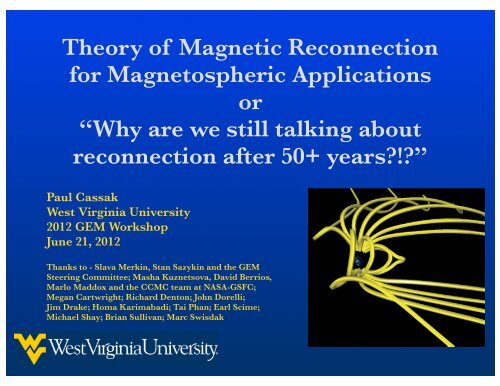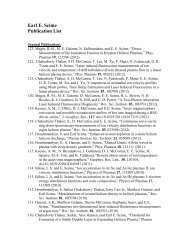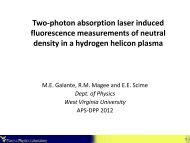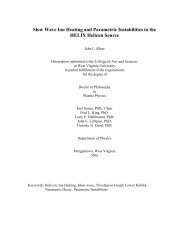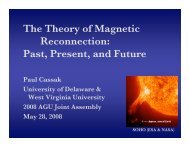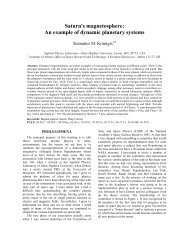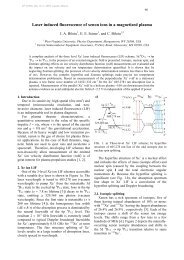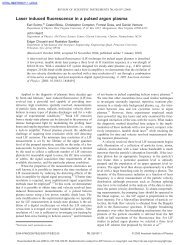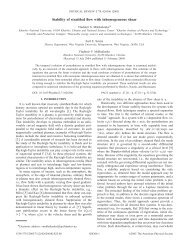reconnection - Plasma Physics at West Virginia University
reconnection - Plasma Physics at West Virginia University
reconnection - Plasma Physics at West Virginia University
Create successful ePaper yourself
Turn your PDF publications into a flip-book with our unique Google optimized e-Paper software.
Theory of Magnetic Reconnectionfor Magnetospheric Applic<strong>at</strong>ionsor“Why are we still talking about<strong>reconnection</strong> after 50+ years?!?”Paul Cassak<strong>West</strong> <strong>Virginia</strong> <strong>University</strong>2012 GEM WorkshopJune 21, 2012Thanks to - Slava Merkin, Stan Sazykin and the GEMSteering Committee; Masha Kuznetsova, David Berrios,Marlo Maddox and the CCMC team <strong>at</strong> NASA-GSFC;Megan Cartwright; Richard Denton; John Dorelli;Jim Drake; Homa Karimabadi; Tai Phan; Earl Scime;Michael Shay; Brian Sullivan; Marc Swisdak
Outline• Early History of Magnetic Reconnection– 1930s through 1981• Middle History of Magnetic Reconnection– 1979 through 2001• Recent History of Magnetic Reconnection– Magnetospheric Applic<strong>at</strong>ions, 2000 - present• The FutureH. Alfven, Keynote Address, Proceedings from NASA Workshop on DoubleLayers, Huntsville AL, March 17-19, 1986.Referring to “magnetic merging”:“I was naïve enough to believe th<strong>at</strong> such a pseudo-science woulddie by itself in the scientific community, and I concentr<strong>at</strong>ed mywork on more pleasant problems. To my gre<strong>at</strong> surprise theopposite has occurred: ‘merging’ pseudo-science seems to beincreasingly powerful. Magnetospheric physics and solar windphysics today are no doubt in a chaotic st<strong>at</strong>e, and a major reasonfor this is th<strong>at</strong> part of the published papers are science and partpseudo-science, perhaps even with a majority in the l<strong>at</strong>ter group." 2
Magnetic Reconnection• An ISI search (06/2012) found >9,100 papers from 1957-2012 on <strong>reconnection</strong>(h-index = 132)600Reconnection Public<strong>at</strong>ions15,000Reconnection Cit<strong>at</strong>ions30010,0005,00019571975199220121958197519922012• Focus of this talk: History and fundamental physics of <strong>reconnection</strong> How fundamental <strong>reconnection</strong> physics enters magnetospheric applic<strong>at</strong>ions• Biases: Mine• To be omitted: Copious references, observ<strong>at</strong>ions,(except where experiments, other applic<strong>at</strong>ionsrelevant) 3
Ronald Giovanelli• Observ<strong>at</strong>ional study of flares (Giovanelli, Ap. J., 1939):– “[M]ost eruptions can be associ<strong>at</strong>edwith particular spot groups.”• New theory of flares (Giovanelli, MNRAS, 1947):– The magnetic field due to a sunspot cancelsthe dipole field <strong>at</strong> a “neutral point.”– Electric fields near neutral points canacceler<strong>at</strong>e particles and drive currents.“The localiz<strong>at</strong>ion of these phenomena in theneighbourhood of sunspots suggests a basisof an explan<strong>at</strong>ion of solar flares.”This theory of flares is electromagnetic,not hydrodynamic!Giovanelli, 19474
Harry Petschek• An aeronautical engineer by training– Introduced to <strong>reconnection</strong> problem by Kantrowitz• Gave a talk <strong>at</strong> AAS-NASA Symposium, <strong>Physics</strong> ofSolar Flares, Greenbelt, Maryland, October 28-30, 1963.– “[P]revious analyses overlooked standingmagneto-hydrodynamic waves as a possible mechanismfor converting magnetic energy to plasma energy.”– Waves become switch-off (slow) shocks if compressible– Reconnection r<strong>at</strong>e fast enough to explain solar flaresOpenoutflowregionPetschek, 1964Small Sweet-Parker regionStanding wavesdrive outflow• Quote from Peter Sweet in the discussion period:“I am in favor of your theory, which I thoroughly approve. Dr. Parker and I havebeen living with this problem for several years and have got the feel of it. Yoursolution struck me <strong>at</strong> once as the solution for which we have been seeking.”All was good - for 22 years… 9
Observ<strong>at</strong>ional Evidence• Ramific<strong>at</strong>ion of <strong>reconnection</strong> on the dayside isconvection p<strong>at</strong>tern <strong>at</strong> the polar caps(Dungey, PRL, 1961)– Flows had been observed with ground basedmagnetometers, but <strong>at</strong>tributed to viscosityDungey, 1961• Indirect evidence of <strong>reconnection</strong> model– Direction of IMF correl<strong>at</strong>ed withauroral and geomagnetic activity(Fairfield and Cahill Jr., JGR, 1966)– Southward IMF implies magnetopauseerosion (Aubry et al., JGR, 1970)– Energetic particles from the sun reachthe field lines <strong>at</strong> the polar cap first(Fennell, JGR, 1973)• Direct evidence (ISEE measurements)– <strong>Plasma</strong> acceler<strong>at</strong>ion <strong>at</strong> a rot<strong>at</strong>ionaldiscontinuity (Paschmann et al., N<strong>at</strong>ure, 1979)– Non-zero component of B field normal tothe magnetopause (Sonnerup et al., JGR, 1981)Overwhelming evidence formagnetospheric <strong>reconnection</strong>!Made using BATS-R-US @ CCMC10
Outline• Early History of Magnetic Reconnection– 1930s through 1981• Middle History of Magnetic Reconnection– 1979 through 2001• Recent History of Magnetic Reconnection– Magnetospheric Applic<strong>at</strong>ions, 2000 - present• The Future11
Collisionless Reconnection• Petschek theory is not self-consistentand the Hall Effect– No physical mechanism given for localiz<strong>at</strong>ion of diffusion region• If η is localized, Petschek-type <strong>reconnection</strong> occurs (S<strong>at</strong>o and Hayashi, Phys. Fluids, 1979)• If η is uniform, it does not (Biskamp, Phys. Fluids, 1986)• If resistivity is not important, wh<strong>at</strong> allows <strong>reconnection</strong>? Considerthe generalized Ohm’s law (Vasyliunas, Rev. Geophys. Space Phys., 1975):E + v × BcConvection= ηJ + J × BnecResistivityHalleffect– The Hall effect alone does not allow for <strong>reconnection</strong>;dissip<strong>at</strong>ion is necessary for the field lines to break.• Not thought to be important (yet!)– Electron pressure and inertia can break frozen-incondition even without resistivity− 1 ne ∇·p e − m eeElectronpressuredv edtElectroninertia• The Hall effect alters the structure between the ion and electron gyro-scales (Sonnerup, 1979).12
The GEM Reconnection Challenge• Help from the fusion community:– Reconnection is much faster than Sweet-Parker<strong>at</strong> length scales below the ion gyro-radius(Aydemir, Phys. Fluids B, 1992)• Hall effect (plus some dissip<strong>at</strong>ion) givesfast <strong>reconnection</strong> (E’ ~ 0.1) (Ma and Bh<strong>at</strong>tacharjee,GRL, 1996; Shay et al., JGR, 1998)Courtesy of M. Shay• Remains fast for large systems (Shay et al., GRL, 1999)• GEM Challenge (Birn et al., JGR, 2001):Same simul<strong>at</strong>ion run with multiple codesby multiple members of the community– Conceived <strong>at</strong> a GEM meeting– Met the following year to compareresults for the first time– All codes with Hall term had fast <strong>reconnection</strong>• 11th most cited <strong>reconnection</strong>paper (473 cit<strong>at</strong>ions)• 3rd most cited JGR-SP paperBirn et al., 200113
Observ<strong>at</strong>ions of Hall Reconnection• Hall <strong>reconnection</strong> is marked by a quadrupoleout-of-plane magnetic field (Sonnerup, 1979)– Attributed to in-plane current– Can also be thought of as dragged out ofthe page by electrons (Mandt et al., GRL, 1994)• Similar to physics of whistler wave– Fast <strong>reconnection</strong> can occur when dispersivewaves in system (Rogers et al., PRL, 2001)• Observed in the magnetosphere ...(Nagai et al., JGR, 2001; Deng and M<strong>at</strong>sumoto, N<strong>at</strong>ure, 2001;Oieroset et al., N<strong>at</strong>ure, 2001; Mozer et al., PRL, 2002)– ... and in labor<strong>at</strong>ory experiments(Ren et al., PRL, 2005; Cothran et al.,GRL, 2005; Frank et al., Phys. Lett. A, 2006)Sonnerup, 1979Hall <strong>reconnection</strong> is therelevant <strong>reconnection</strong> modelin the magnetosphereMozer et al., 200214
Outline• Early History of Magnetic Reconnection– 1930s through 1981• Middle History of Magnetic Reconnection– 1979 through 2001• Recent History of Magnetic Reconnection– Magnetospheric Applic<strong>at</strong>ions 2000 - present• Dayside - Solar Wind-Magnetospheric Coupling• Dayside - Flux Transfer Events• Sign<strong>at</strong>ures/Microphysics of Reconnection• Nightside - Particle Acceler<strong>at</strong>ion• Nightside - Dipolariz<strong>at</strong>ion Fronts• The Future15
Solar Wind-Magnetospheric Coupling• A major goal of space we<strong>at</strong>her (and GEM!) research– Predicting geomagnetic activity from conditions in the solarwind• Long history (Newell et al., JGR, 2007)– By l<strong>at</strong>e 70s, it was thought to berel<strong>at</strong>ed to solar wind electric field– “Axford conjecture”: solarwind convection electricfield determines the <strong>reconnection</strong>electric field (Axford, Rev. Geophys., 1969)• Attempts to quantify thisstarted simple– Modern studies use observedd<strong>at</strong>a to fit to reasonable functionalforms and get a best fit• “Empirical” approach, promoted byB. McPherron in 2008(?) GEM Tutorial– Can achieve ~75% correl<strong>at</strong>ion!Newell et al., 200716
Recent Developments• Borovsky and Denton (GRL, 2006)studied effect of “plasmasphericdrainage plumes” on SW-MScoupling– They occur when pulse in SWmake <strong>reconnection</strong> faster, pulls inm<strong>at</strong>erial from plasmasphere– Borovsky showed SW-MS couplingbecomes less efficient when a plumereaches dayside magnetopause• Higher density decreasesthe Alfven speed, makes<strong>reconnection</strong> slowerSandel et al., Space Sci. Rev., 2003via R. Denton’s GEM tutorial, 2011– SW-MS coupling influenced bylocal <strong>reconnection</strong> physics– Calls Axford conjecture into question17
Quantifying the Coupling• “Borovsky conjecture:” local dayside<strong>reconnection</strong> physics controlsSW-MS coupling (Borovsky, JGR, 2008)– Must predict <strong>reconnection</strong> efficiency (r<strong>at</strong>e)as a function of parameters <strong>at</strong> the daysideB 12δ2LB 2v 2ρ 2– The dayside is usually asymmetric (different B and n)– Need a Sweet-Parker-type analysis for asymmetric<strong>reconnection</strong> (Cassak and Shay, Phys. <strong>Plasma</strong>s, 2007)( ρ 1v 1+ ρ 2v 2 ) L ~ ( ρ outv E ~out )2δ1 ⎛⎛ 2B 1B 2⎞⎞c⎜⎜B 1+ B⎟⎟⎝⎝2 ⎠⎠v δReconnection R<strong>at</strong>eoutL2B 18π v + B 2⎛⎛2⎜⎜ 18π v ⎞⎞ ⎛⎛2⎟⎟ L ~1⎝⎝⎠⎠ 2 ρ v ⎞⎞2out out⎝⎝⎜⎜⎠⎠⎟⎟ v 2δ2vout out~ B B B1 2 1+ B 2~ B B 1 2Outflow speed4π ρ 1B 2+ ρ 2B 14πρ outv 1B 1~ v 2B 2ρ out~ ρ B + ρ B 1 2 2 1Outflow densityB 1+ B 2• This follows from first principles!• Independent of dissip<strong>at</strong>ion mechanism, generalizes E ~ (1/c) B cA (δ / L)• Scaling in 2D rectangular box has now been well tested numerically(Birn et al., 2008; Cassak and Shay, GRL, 2008; Phys. <strong>Plasma</strong>s, 2009; Malakit et al., 2010)– Scaling in magnetospheric geometry tests well for southward IMF (Borovsky et al., JGR,2008; Sullivan et al., 2010), but has not been established for any other conditionsρ outv 1v outρ 118
The Borovsky Coupling Function• Start with expression for <strong>reconnection</strong> r<strong>at</strong>e(in SI units, “ms” = magnetosphere,“sh” = magnetoshe<strong>at</strong>h) (Borovsky, JGR, 2008)E ∼∼2B shB ms δv outB sh + B ms L2B shB msB sh + B msB sh B msµ 0B sh + B msρ sh B ms + ρ ms B shδLCourtesy of NASA– Next, rel<strong>at</strong>e local quantities to properties of solar wind• Use arguments on pressure balance, shock theory,some semi-empirical rel<strong>at</strong>ions, assume δ/L ~ 0.1Ex : B2 ms8πE ∼ 0.4µ 1/20 sin(θ/2)ρ SW vSW(1 2 + 0.5Mms)(1 −2 + β sh ) −1/2Cρ SW +(1+β sh ) −1/2 ρ ms −1/2 (1 + β sh ) 1/2 +1∼B2 sh8π + P sh ∼ B2 SW8π −1/2• Tested result with OMNI2 d<strong>at</strong>a, correl<strong>at</strong>ed <strong>at</strong> 75% level (Borovsky, JGR, 2008)– Comparable to the best previous empirical fitting result(Newell et al., JGR, 2007), but comes (mostly) from first principles!+ P SW + 1 2 ρ SWv 2 SWMany assumptions th<strong>at</strong> require testing, but thissuggests first principles - and fundamental <strong>reconnection</strong>physics - can be important to SW-MS coupling!19
Dayside - Flux Transfer Events• Closed tubes of magnetic flux are observed<strong>at</strong> the dayside, called Flux Transfer Events(Russell and Elphic, Space Sci. Rev., 1978)– Widely thought to be a result of non-steady(bursty) <strong>reconnection</strong> on the dayside• How FTEs are manifested becomes a fundamentalphysics question about <strong>reconnection</strong>Russell andElphic, 1979• Burstiness appears even in 2D<strong>reconnection</strong>– Occurs in collisional (Sweet-Parker)<strong>reconnection</strong> when S > S crit ~ 10 4(Biskamp, Phys. Fluids, 1986)– Also occurs in collisionless PIC simul<strong>at</strong>ions(Daughton et al., Phys. <strong>Plasma</strong>s, 2006)• Are the two manifest<strong>at</strong>ions the same?• Large-scale global hybrid simul<strong>at</strong>ions[1 trillion (!) particles] reveal copiousproduction of FTEs (Karimabadi et al., 2010)Courtesy of H. KarimabadiDevelopment of large-scale kinetic simul<strong>at</strong>ionsallow unprecedented opportunity to study productionand effects of FTEs in collisionless systems20
Sign<strong>at</strong>ures and Microphysics• Observ<strong>at</strong>ions of magnetospheric <strong>reconnection</strong> requireknowledge of its micro- and meso-scale sign<strong>at</strong>ures– Example 1 - Two-scale structure of electrondiffusion region• Electron layer longer than originally thought (Daughton et al.,Phys. <strong>Plasma</strong>s, 2006; Shay et al., PRL, 2007; Karimabadi et al., GRL,2007; Klimas et al., Phys <strong>Plasma</strong>s, 2008)– Electron layer has two scales, inner layer known alreadyand outer layer th<strong>at</strong> does not cause a bottleneck– Outer layer is frozen-in in different reference frame;diamagnetic effects are important in the outer region(Hesse et al., Phys. <strong>Plasma</strong>s, 2008)• New measure of frame-independent dissip<strong>at</strong>ion; confirmedouter layer is not dissip<strong>at</strong>ive (Zenitani et al., PRL, 2011)Zenitani et al., 2011– Example 2 - “Quadrupole” structure of Hall B fields• Hall magnetic fields are quadrupolar (Sonnerup, 1979)• Becomes more bipolar when there is a strong asymmetry,as is expected <strong>at</strong> the dayside Karimabadi et al., JGR, 1999;Mozer et al., GRL, 2008; Tanaka et al., Ann. Geophys., 2008)• Structure of Hall field is rel<strong>at</strong>ed to the substructure of thedissip<strong>at</strong>ion region in asymmetric <strong>reconnection</strong> (rel<strong>at</strong>iveloc<strong>at</strong>ion of X-line and stagn<strong>at</strong>ion point) (Malakit et al., in prep)Studies of fundamental physics of <strong>reconnection</strong> canhelp determine observable properties in magnetosphere Malakit, 201221
Particle Acceler<strong>at</strong>ion• Wh<strong>at</strong> is the role of magnetic <strong>reconnection</strong> in particle acceler<strong>at</strong>ion?– Giovanelli argued particles are acceler<strong>at</strong>ed by the <strong>reconnection</strong> electric field• The dissip<strong>at</strong>ion region is very small; only few particles would acceler<strong>at</strong>e• Recent models -– Is acceler<strong>at</strong>ion near <strong>reconnection</strong> sites caused by the physics of <strong>reconnection</strong> or a secondary mechanism?– Collision of outflow jet with plasma inisland (Hoshino et al., JGR, 2001)– Parallel electric fields in density cavities(Drake et al., PRL, 2005; Pritchett, JGR, 2006).– Contracting magnetic islands; theory(Drake et al., N<strong>at</strong>ure, 2006) and observ<strong>at</strong>ions(Chen et al., N<strong>at</strong>ure Phys., 2008)– Island coalescence (Oka et al., ApJ, 2010)– Parallel electric field in islands(Oka et al., JGR, 2010)– Parallel electric field caused by an electrontemper<strong>at</strong>ure anisotropy due to trapped electronsin inflow region (Egedal et al., JGR, 2008; N<strong>at</strong>ure Phys., 2012)Drake et al., N<strong>at</strong>ure, 200622
M’Tail - Dipolariz<strong>at</strong>ion Fronts• Substorms and bursty bulk flows lead to a dipolariz<strong>at</strong>ion ofthe terrestrial magnetic field (e.g., Baumjohann et al., JGR, 1990;Angelopoulos et al., JGR, 1992; Ohtani et al., JGR, 2004)– Originally thought to be theeffect of m<strong>at</strong>erial running intomagnetospheric field• Recent simul<strong>at</strong>ions (Sitnov et al.,JGR, 2009) and observ<strong>at</strong>ions(Runov et al., GRL, 2009; JGR,2011) suggest it is a genericfe<strong>at</strong>ure of <strong>reconnection</strong> asnewly reconnected field linesstraighten, which explains whythey occur in many loc<strong>at</strong>ionsin the magnetotailSitnov et al., 2009• Compresses normal magnetic field, this may be importantas a seed loc<strong>at</strong>ion for ion and electron he<strong>at</strong>ing• Manifests differently depending on equilibrium fields (Sitnov and Swisdak, JGR, 2011)• Rel<strong>at</strong>ed to retre<strong>at</strong> of <strong>reconnection</strong> site in magnetotail (Oka et al., GRL, 2011)• Propag<strong>at</strong>ion speed scales with Alfven speed, faster DFs reflect ions (Wu and Shay, GRL, 2012)23
Outline• Early History of Magnetic Reconnection– 1930s through 1981• Middle History of Magnetic Reconnection– 1979 through 2001• Recent History of Magnetic Reconnection– Magnetospheric Applic<strong>at</strong>ions 2000 - present• The Future24
Near Future - MMS Mission• Magnetospheric Multi-Scale (MMS) Mission– NASA Mission scheduled for 2014– Similar to Cluster (4 s<strong>at</strong>ellites),but closer together• Goal is to understand micro-scale(electron) physics of <strong>reconnection</strong>• Will afford unprecedentedsp<strong>at</strong>io-temporal resolution– Excellent opportunity to testtheory/simul<strong>at</strong>ionCourtesy of MMS• Much theoretical work needsto be done to prepare– Example - sign<strong>at</strong>ures of <strong>reconnection</strong>The next few years will be anexciting time for <strong>reconnection</strong>!26
An Appeal• Despite a very successful past, there is currently no GEM Focus Groupon fundamental <strong>reconnection</strong> physics (previous one ended in 2010)– Aspects arise in many existing focus groups (> 8 out of 12!)• Near Earth Magnetosphere• <strong>Plasma</strong>sphere-Magnetosphere Interactions• Substorm Expansion Onset: The First 10 Minutes• Modes of Solar Wind-Magnetosphere Energy Transfer• The Magnetoshe<strong>at</strong>h• Metrics and Valid<strong>at</strong>ion• Tail-Inner Magnetosphere Interactions• Transient Phenomena <strong>at</strong> the Magnetopause and Bow Shock and Their Ground Sign<strong>at</strong>ures• Many open questions would benefit by being addressed as fundamental physics!– Micro- to macro-scale, SW-MS coupling, FTEs, 3D <strong>reconnection</strong> (a new GEM challenge?),how to parametrize in global fluid codes, the march toward global kinetic modeling,particle acceler<strong>at</strong>ion, ...• Need to encourage interaction between observers, theorists, and modelers– Especially important with impending launch of MMSPlease contact me <strong>at</strong> Paul.Cassak@mail.wvu.edu if you would liketo be on the mailing list for a potential <strong>reconnection</strong> Focus Group!27
Conclusion• “So the physics of rapid <strong>reconnection</strong> has come a long way in the halfcenturysince it was first proposed.” (Parker, Convers<strong>at</strong>ions on Electric and MagneticFields in the Cosmos, 2007)• Contributors to magnetic<strong>reconnection</strong> theory:– solar observers, plasma theorists,solar theorists,aeronautical engineers,fusion experimentalists,fusion theorists,magnetospheric observers,astrophysicists,<strong>reconnection</strong> numericistsand experimentalists• Reconnection has a rich history,and it’s still being written!• Thank you!http://www.msfc.nasa.gov/Email - Paul.Cassak@mail.wvu.edu28


